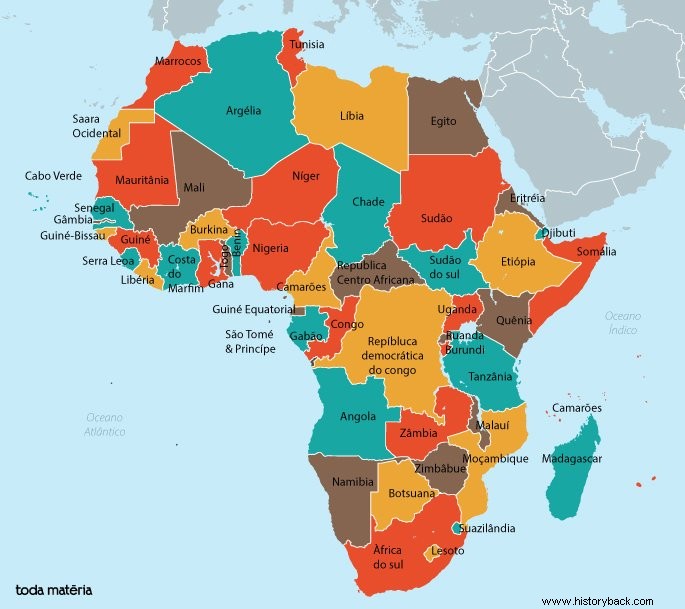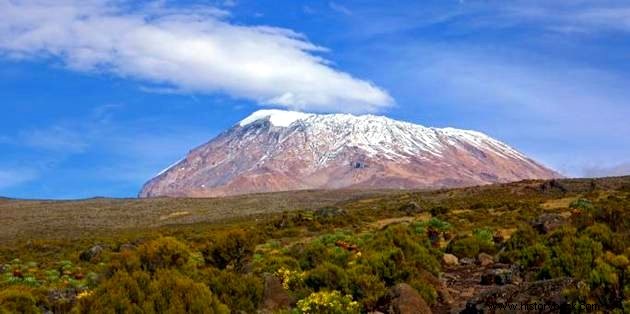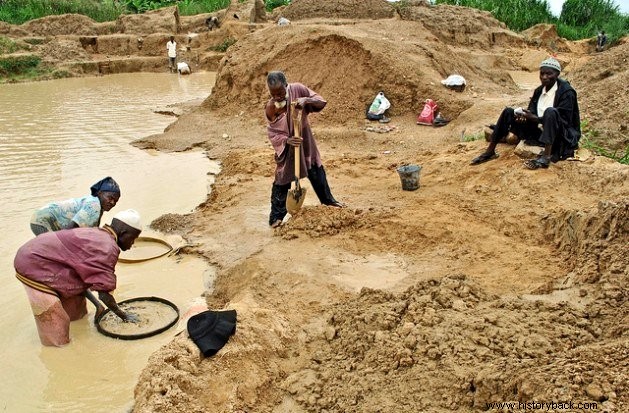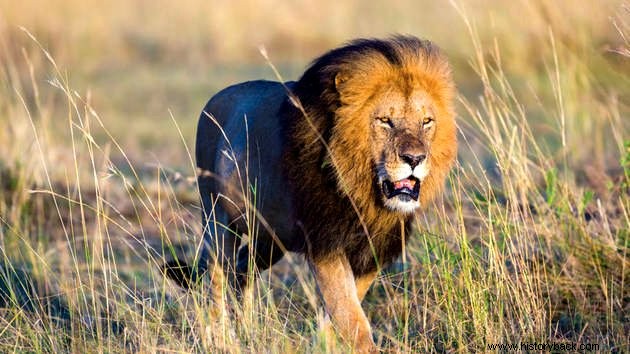The Africa It is the 3rd continent in territorial extension, with 30 million km², occupying 20.3% of the Earth's total area.
Despite concentrating countless natural resources, the African continent is one of the poorest in the world.
Africa is bordered by the Atlantic Ocean on its western coast and the Indian Ocean on the eastern side. To the north, by the Mediterranean and Red Seas and to the south, by the Antarctic Sea.
Countries of Africa
The African continent has 54 countries, 48 of which are on the continent and six are insular. The population is 1.2 billion.
Algeria is the largest in territorial extension with 2 381 741 km². On the other hand, the Seychelles islands are the smallest country on the continent with 455 km².
We can divide the African continent into two major regions:North Africa and Sub-Saharan Africa.

Northern Africa or North Africa
Seven countries form the region known as North Africa or North Africa:
- Algeria
- Egypt
- Libya
- Morocco
- Western Sahara
- Sudan
- Tunisia
Sub-Saharan Africa or Southern Africa
The so-called Sub-Saharan Africa is formed by the following countries:
- South Africa
- Angola
- Benin
- Botswana
- Burkina Faso
- Burundi
- Shrimps
- Cape Verde
- Chad
- Congo
- Ivory Coast
- Djibouti
- Equatorial Guinea
- Eritrea
- Ethiopia
- Gabon
- Gambia
- Ghana
- Guinea
- Guinea-Bissau
- Comoros Islands
- Lesotho
- Liberia
- Madagascar
- Malawi
- Mali
- Mauritania
- Mauricio
- Mozambique
- Namibia
- Niger
- Nigeria
- Kenya
- Central African Republic
- Rwanda
- Democratic Republic of Congo
- São Tomé and Príncipe
- Senegal
- Seychelles
- Sierra Leone
- Somalia
- South Sudan
- Swaziland
- Tanzania
- Togo
- Uganda
- Zambia
- Zimbabwe
Islands
In the Atlantic Ocean are the Canary Islands, the archipelagos of São Tomé and Príncipe and Cape Verde. In the Indian Ocean, the islands of Madagascar, Comoros, Mauritius, Seychelles and Réunion are located.
Geology

The African geological base is very old, which explains the low altitudes. However, we do have some high points, such as Mount Kilimanjaro (to the east, on the Ethiopian Highlands) and the Atlas Mountains (to the north of the continent).
Africa occupies a single tectonic plate, unlike Europe which shares its plate with Asia (Eurasian plate).
In addition, it is made up, for the most part, of plateaus and coastal plains, which can be immensely large, such as the Niger plains.
Relief

Northern Highlands
On the northern plateau is the Sahara Desert, which is the most extensive hot desert in the world with 9.2 million km² and the Atlas Mountains, which reaches more than 4000 meters in height at the highest points.
The Nile River runs through this area, with 6755 km, the longest in Africa and the second in the world. The Nile was the cradle of the first civilizations in history, such as the Egyptian one.
South of the Sahara we have the Chad Basin, with 2 382 000 km² which is a source of fishing for the local population. There is also the Niger River, which is 4180 kilometers long.
Eastern Plateau
In the eastern part of the continent is the Rift Valley, the largest tectonic trench in the world, which forms a valley 4000 km long, narrow and deep. There, traces of the first human groups were found.
In the same way, it is the region of the great lakes and the highest points of the continent, in which Kilimanjaro stands out with 5895 meters.
Southern Plateau
In the southern part of the continent we find the deserts of Namibia and Kalahari, called "brothers" because they are very close.
The southernmost point of the continent is Cabo das Agulhas, which is located near the Drakensberg Mountains.
The Congo basin, located in the equatorial zone of the continent, has an enormous forest, the 2nd in the world, behind only the Amazon.
Religion
From a religious point of view, Islam, Christianity and traditional African religions predominate.
We can divide, in a general way, that in North Africa the predominant religion is Islam and in Sub-Saharan Africa, Christianity is the majority. Ethiopia, for example, has the oldest Christian churches on the continent.
Protestant Christianity is also present due to English, German and Dutch colonization.
African animist religions continue to be practiced by local people, both in rural and urban areas.
Languages
Across the continent, 2,000 languages and countless dialects are spoken. In addition to the various languages of African origin, some of the languages introduced by the colonizers are still used today:Arabic, English, French, Portuguese and Spanish.
In certain countries, such as the Seychelles, the colonizer's language, French, was mixed in such a way with the local language that it is already considered another language:criollo .
For this reason it is easy to find Africans who are truly multilingual. South Africa, for example, has 11 official languages.
Population
Africa is the second most populous continent on the planet, with nearly one billion people. The population density is around 44 inhabitants per square kilometer.
The Nile valley has a population density of 500 inhabitants/km², while deserts and forests are practically uninhabited.
Few African countries have urban populations that are numerically higher than rural ones, such as Algeria, Libya and Tunisia
The largest portion of the African population is composed of different black peoples, of which the most prominent groups are Bantu, Nilotic, Pygmies, Bushmen.
There is a significant amount of white people in the northern part of the continent, in the Maghreb region.
History and Colonization of Africa
The beginnings of its colonization date back to the Quaternary era or the end of the Tertiary era, and everything indicates that the human being has its origins in this continent.
North Africa is the oldest region in the world occupied by humans. The hominid fossils found there, in Tanzania, Ethiopia and Kenya, are about five million years old.
The name "Africa" is usually related to the Phoenicians as "afar", which means "dust" and
In Egypt there was the first state to be constituted in Africa, with about 5000 years. Later, with the aim of finding new ways to the Indies, the Europeans will launch themselves on the African continent.
There were also great African civilizations on the continent, such as that of Askum (from the 1st to the 16th century), in Ethiopia, and that of Ghana (from the 5th to the 11th century).
There were powerful Muslim states such as Mali (13th to 15th century), Songhai (15th to 16th century), the Abomey kingdom of Benin (17th century). Finally, the Zulu Confederation of Southeast Africa (19th century).
European Colonization
In the 15th century, explorers from Europe conquered the coast of West Africa and from the 19th century onwards, European powers began to colonize the interior.
In the beginning, Portugal dominated Angola, Mozambique, Guinea and strategic islands such as Tomé and Príncipe. Likewise, Portugal and other countries removed around eleven million people from Africa and enslaved them in their colonies.
In the 19th century, the Berlin Conference would literally make official the imperialist advance on the European continent.
The United Kingdom will occupy a strip from north to south, from Egypt to South Africa, in addition to other areas it has colonized in the Gulf of Guinea. France will settle in northwest Africa, the African equator and Madagascar.
Finally, in smaller numbers, we have Germany, which is established in Togo, Tanganyika and Cameroon; and Belgium, in the Belgian Congo and Rwanda.
Italy, Libya, Ethiopia and Somalia; and Spain, will occupy part of Morocco, present-day Western Sahara and enclaves in Guinea.
However, the African colonies announced their independence, especially after the Second World War, in a process that would end between 1960 and 1975.
After independence, there were separatist uprisings and coups d'état, which culminated in truculent dictatorships.
Thus, in most cases, political independence was only a prerogative of the moment, as, as a rule, the new countries maintained economic ties with their respective former metropolises.
Economy

Africa is the poorest continent in the world:of the thirty poorest countries, at least 21 are African.
Extractivism and agriculture are among the main activities in Africa. These are practiced with very low technological levels and, therefore, are very harmful to the environment and local workers.
Hunting, fishing and gathering natural products still make up the main sources of income for the majority of the African population. It is worth mentioning the trade in leather and fur, ivory, wood, resins, palm oil and spices.
However, in the 21st century, due to the increase in the price of primary products, the African economy has experienced a considerable increase. The region's growth rates reached up to 9% in the period 2004-2015.
Extractivism
Africa has large mineral reserves, especially gold and diamonds, as well as energy sources such as oil and natural gas. It is also abundant in antimony, phosphates, manganese, cobalt and copper.
The largest African economy is Nigeria, followed by countries such as South Africa and Algeria (large exporters of phosphates, a raw material for the fertilizer industry).
Some of the African countries are even members of OPEC (Organization of Petroleum Exporting Countries), such as Angola, Algeria, Libya and Nigeria.
However, the exploitation of mineral wealth is practiced by European or North American companies, which are attracted by the low price of labor, electricity and raw materials.
These companies extract and produce at reduced costs, which allows them high profit margins.
Agriculture
Agriculture on the African continent, on the other hand, takes two forms:subsistence and commercial.
The first is rudimentary, itinerant and extensive, and the second, practiced under the old form of Plantation , a system introduced by Europeans during the colonial period.
The main agricultural export products are tropical fruits such as bananas, cashews, coffee and flowers.
Livestock
Due to the unfavorable natural conditions for raising cattle, Africa has in livestock an economic activity of domestic scope.
See also:Economy of AfricaFauna and Flora

The African fauna is very rich and has the largest animals on earth. In the savannas and steppes, antelopes, zebras, giraffes, lions, leopards and elephants populate.
In the equatorial forest we can find a wide variety of birds and monkeys.
Thanks to precipitation, the predominant vegetation is the equatorial forest. To the north and south of this strip, a region with hot and humid summers, savannas appear, which are the most striking type of vegetation on the continent.
In the Mediterranean Sea and in South Africa, the Mediterranean vegetation stands out, with shrubs and grasses.
Weather
As for the climatic types, the following stand out:equatorial, tropical, desert and Mediterranean.
The equatorial climate, hot and humid all year, is located in the central-west region of the continent, covering more than 50% of the continent. Only the north and south of the continent have a temperate climate.
The hot tropical climate with dry winters dominates the African continent as a whole and the Mediterranean climate emerges in small parts of the northern tip and southern tip of the continent.
Deserts occupy the rest of the territory, as rainfall is rare in the vicinity of the Tropic of Cancer, where the Sahara Desert is located, and the Kalahari, found in the Tropic of Capricorn.
The Sahel, a transition zone between the desert and the equatorial forest, is one of the areas where temperatures are more pleasant, with less rainfall and very pronounced dry seasons.
Curiosities
- The River Nile can be seen from space.
- Hunger hits thirty African countries with extreme force, especially those in the areas adjacent to the Sahara Desert.
- The current political division of Africa was configured in the 60s and 70s, forming 54 independent countries.
- Africa is the only continent in the world cut by three parallels:the Equator, as well as the Tropics of Cancer and Capricorn.
